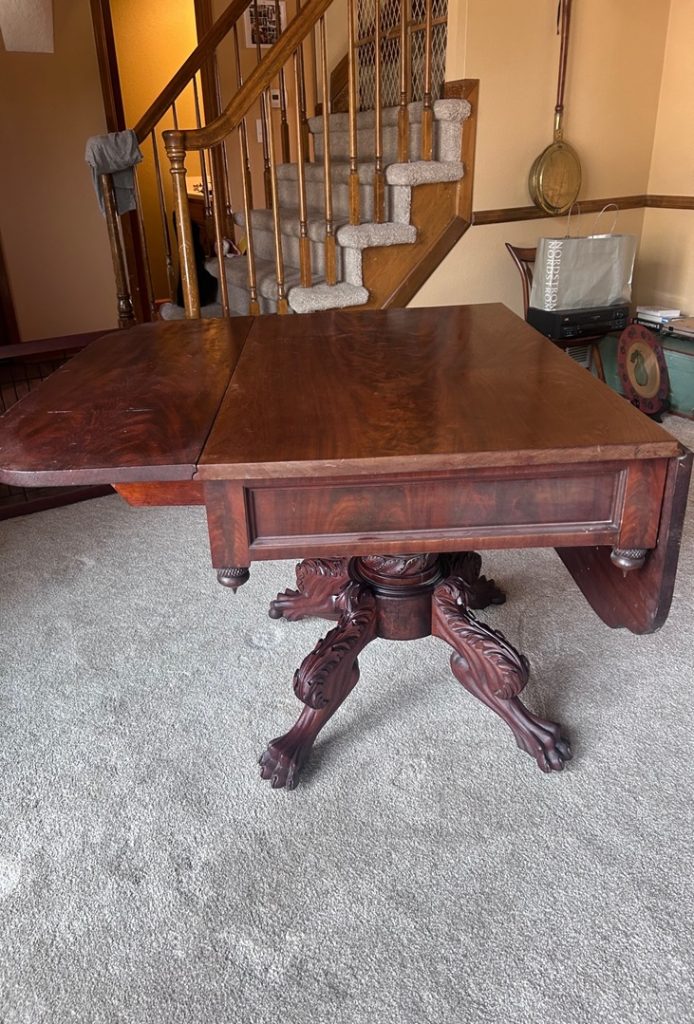Phyfe Furniture

HH was told by his grandmother from Boston that the table she left him was made by Duncan Phyfe. Almost everyone who has an East Coast Grandma runs the risk of being told that her family’s furniture was made by Phyfe. For years after his death, Phyfe’s furniture was NOT collected nor desired; it wasn’t till the 1920s, a hundred years after his style was popular, that Classical Mahogany began to be reproduced, and his original pieces were given museum shows.
Phyfe employed over 300 craftsmen over time who copied his style from 1805-1840s. He was mainly a New York designer although he worked for the social elite of Philadelphia and, especially, the plantations of the Old South. Look for anything that reminds you of Greece or Rome, because Phyfe’s style is Neoclassical, using elements such as lion’s masks, lion’s paw feet, acanthus leaf carvings, reeding, lyres, scrolls, and saber-shaped legs on chairs. He used fruitwoods such as mahogany, cherry, and rosewood, and touched his pieces with very thin veneers for accents.
Strange that a poor boy from Loch Fannich in Scotland should become the nation’s foremost designer in the Neoclassical (Greek and Roman) style, practicing in New York City for 55 years, employing and later partnering with his sons. After the turn of the century from the 18th to the 19th, Classicism became the rage till the 1840s when taste changed to historical revival styles such as the Gothic, the Rococo, and the Italian Renaissance. And Phyfe was the style’s most famous cabinetmaker.
The Neoclassical style was a worldwide phenomenon which touched architecture (every U.S. town’s main street had a Parthenon style bank building), furniture, painting and sculpture, fashionable clothing, literature, and interior design. Two world events ushered in the craze. The first was the mid-18th century discovery of Pompeii and Herculaneum by the German father of archaeology, JJ Winckelmann, who wrote extensively about the ruins. Winckelmann wrote as well about some of the intact buildings of Herculaneum, preserved by 25 meters of volcanic ash. Both cities were frozen in time by the eruption of Mount Vesuvius in 79 AD. The style of the Classical world was then made famous by a Roman artist, Piranesi, whose prints were collected by the privileged young English and European men taking The Grand Tour of Italy and the Classical World, bringing works of art back home with them after years abroad spent refining their “tastes.” Thus, the discovery of the ancient ruins and the popularity of The Grand Tour in the late 18th century began the Neoclassical era. Phyfe’s many forms of furniture designs were in this style until he retired at almost 80 years old.
Much of the furniture he designed is described now as refined and elegant, as opposed to the later Neoclassical period furniture in the Empire style (after Napoleon’s reign as Emperor and his taste for Roman style). Phyfe was known for portraying parts of animals in his furniture, a tradition that springs from the Roman style of using carved animal legs and feet on the legs of chairs and tables. For example, on the table that HH sends me, I note the “Hairy Knees” which jut out from those four arched legs, which terminate in cat’s claw or lion’s paw feet. They are meant to look like feline feet, and if they aren’t carved in wood to resemble hairy feet, or talons clutching a ball, they will be cast in bronze as casters to resemble animal feet.
A favorite motif of Phyfe’s was the relief face of a lion’s pelt as worn by Hercules as a cape. Phyfe reached back to Classical myth for some of his imagery. Although it is ubiquitous today, as it has been copied so much, the harp or lyre-backed chair was his invention. The pedestal-based table – Phyfe’s dining table, for instance – is also a Classical element which borrowed from nature. These pedestals (as in the photo) are carved with the design of acanthus leaves, seen originally on the Corinthian columns in Greek architecture.
Far removed from his childhood Scottish crofter’s cottage, the unique Classical elements of Duncan Phyfe’s furniture were known throughout the world. These pieces are such a part of how we think about furniture that we forget that once they were totally new design concepts. Duncan Phyfe’s furniture can be seen in the Green Room at the White House, Edgewater, Roper House, and especially at Millford Plantation in South Carolina, owned by the Classical American Homes Preservation Trust.







You must be logged in to post a comment.